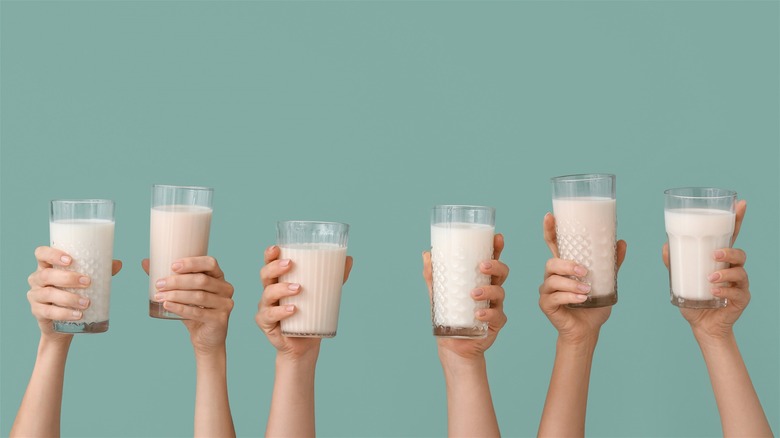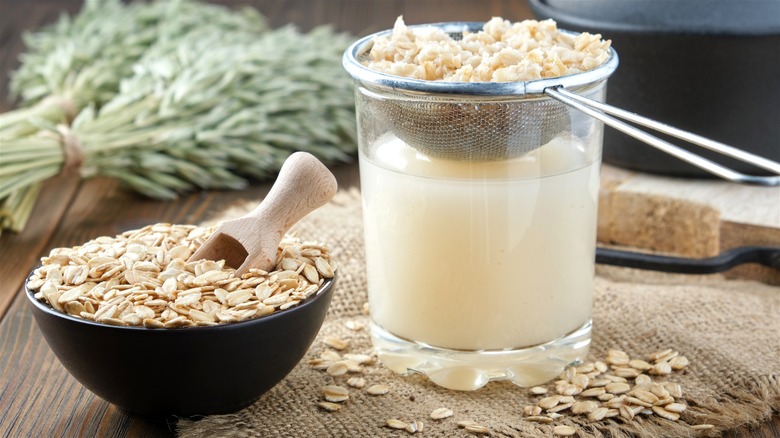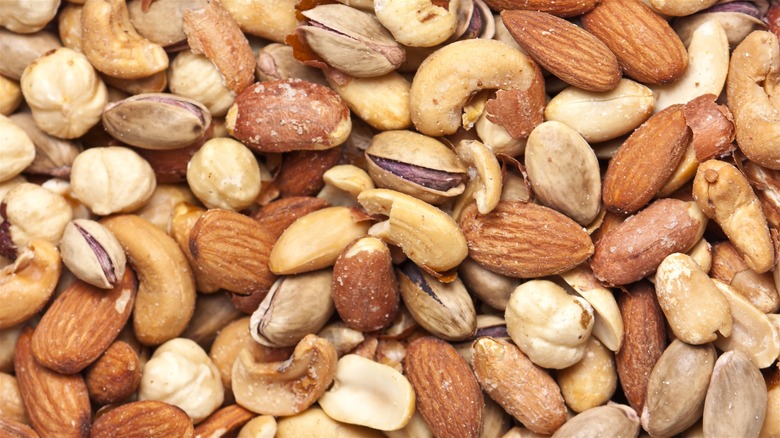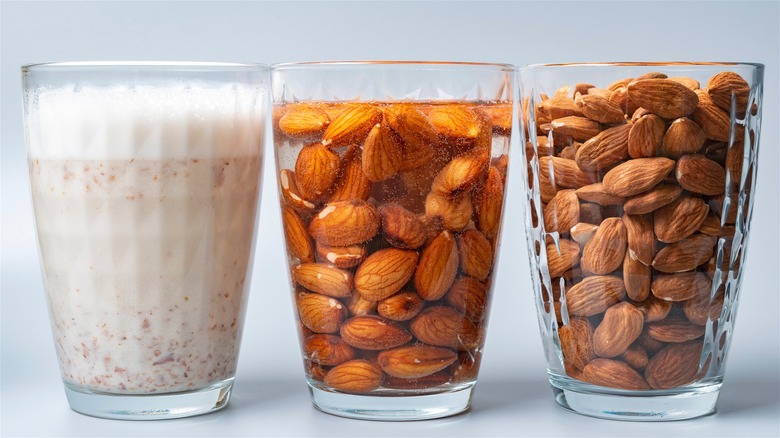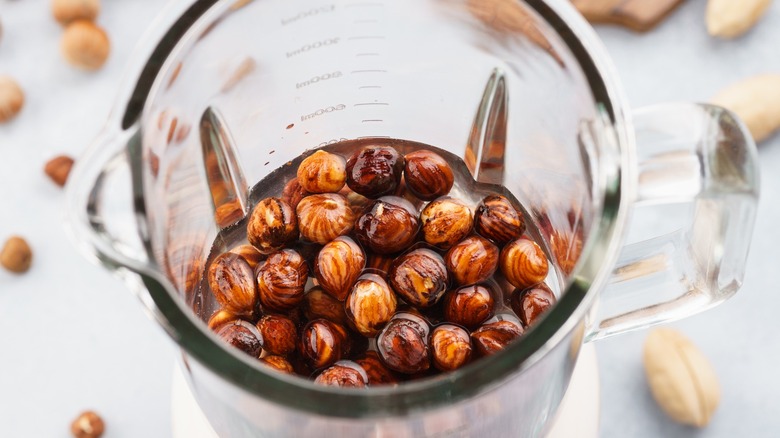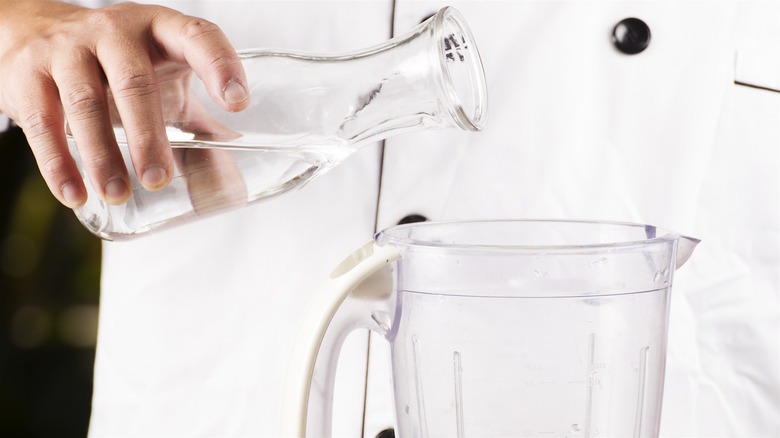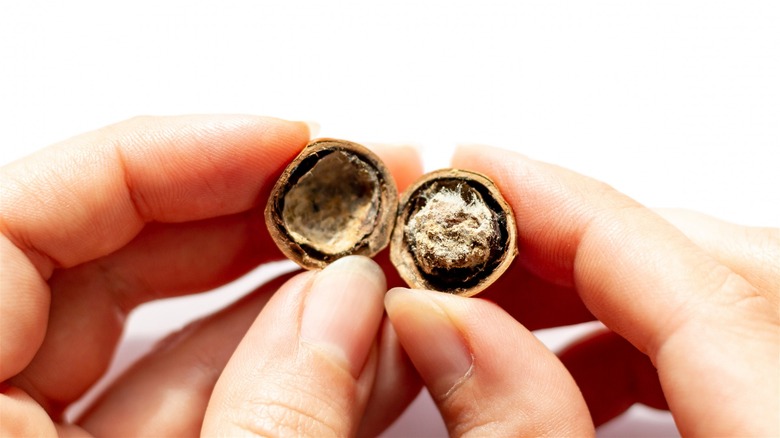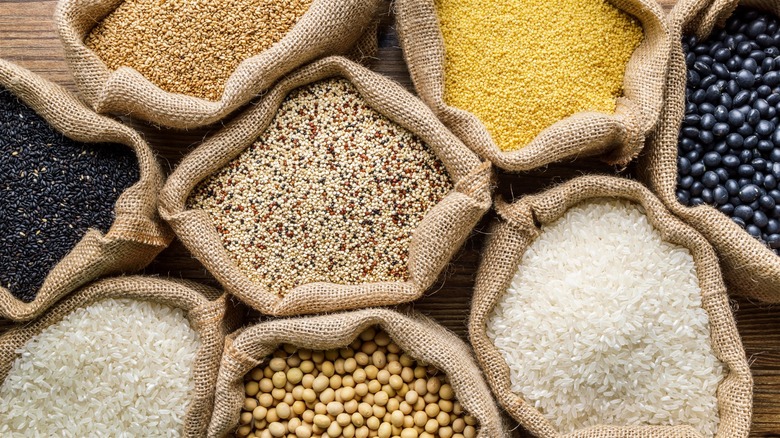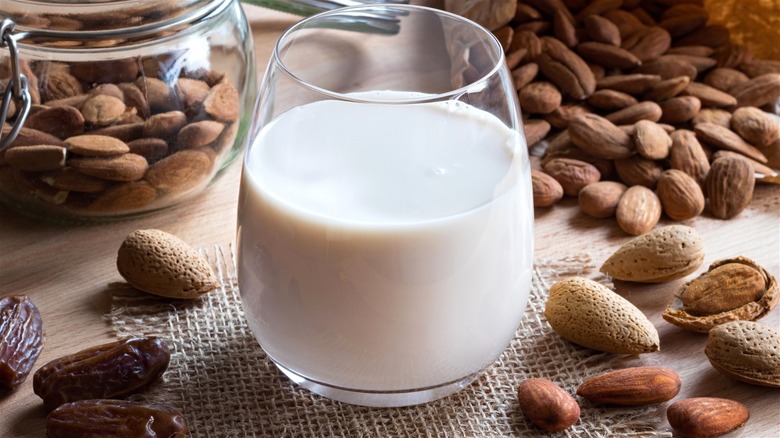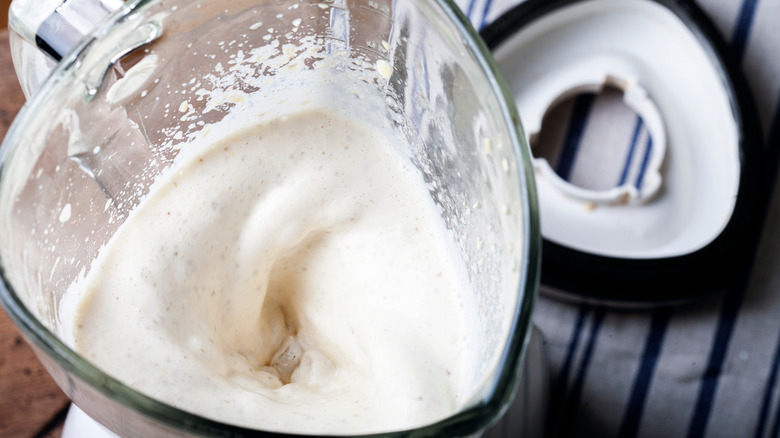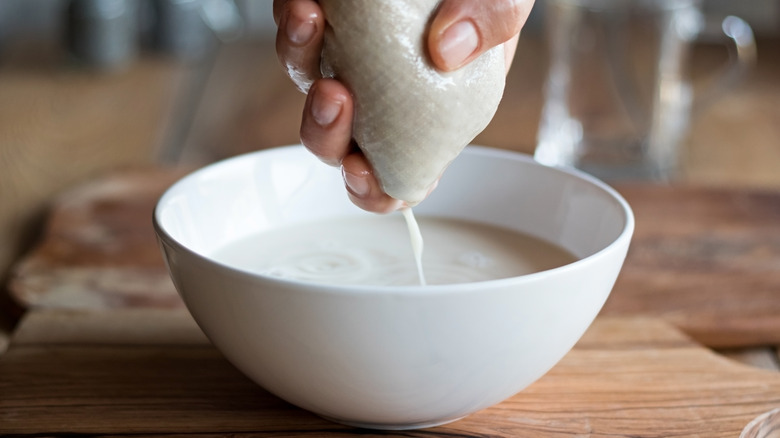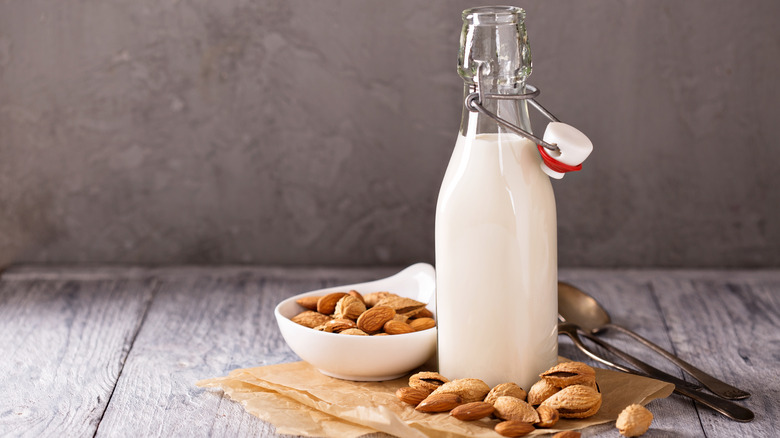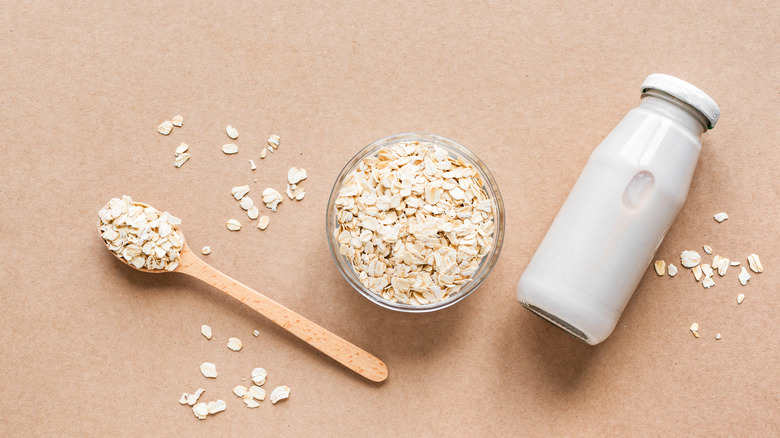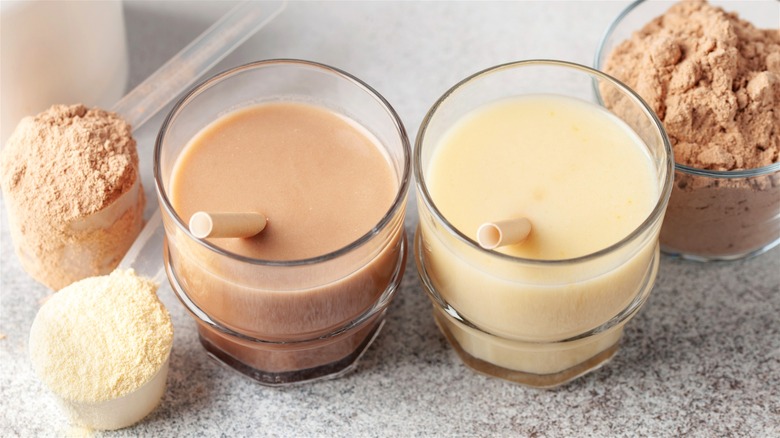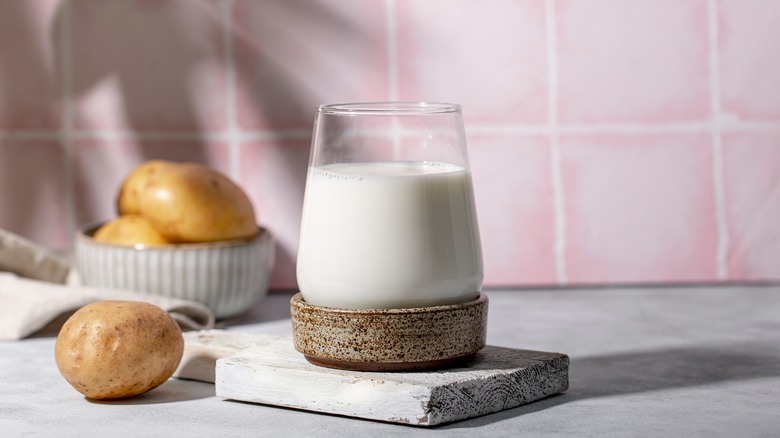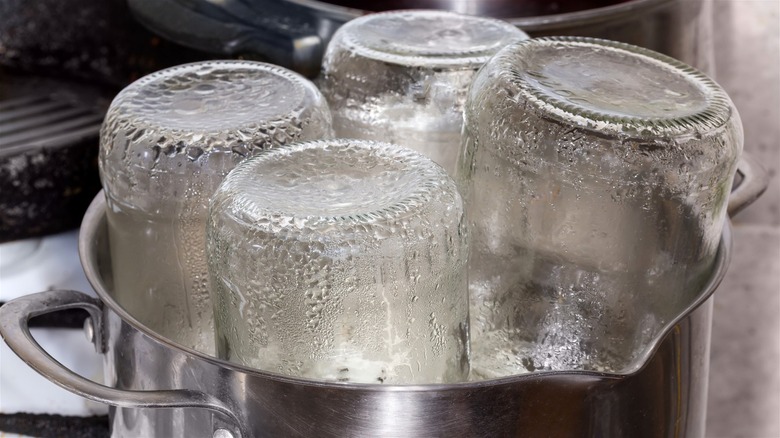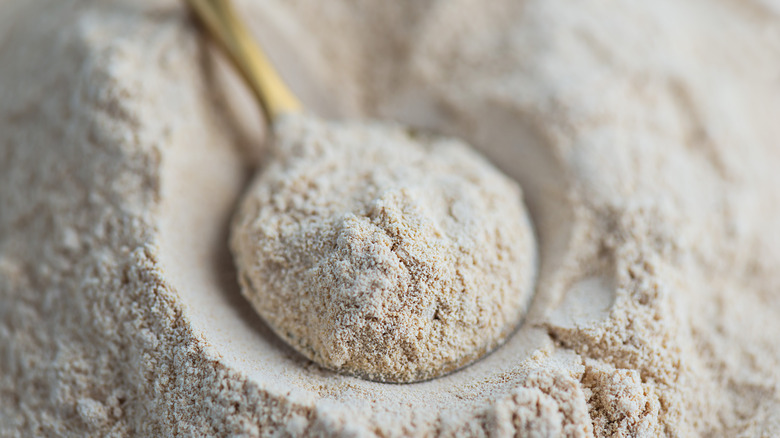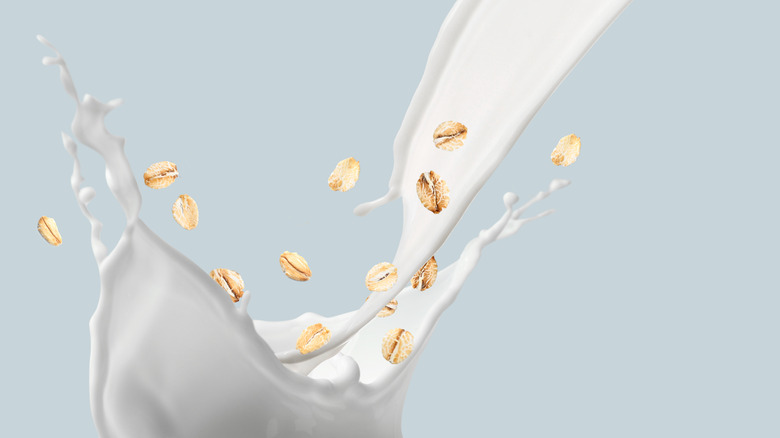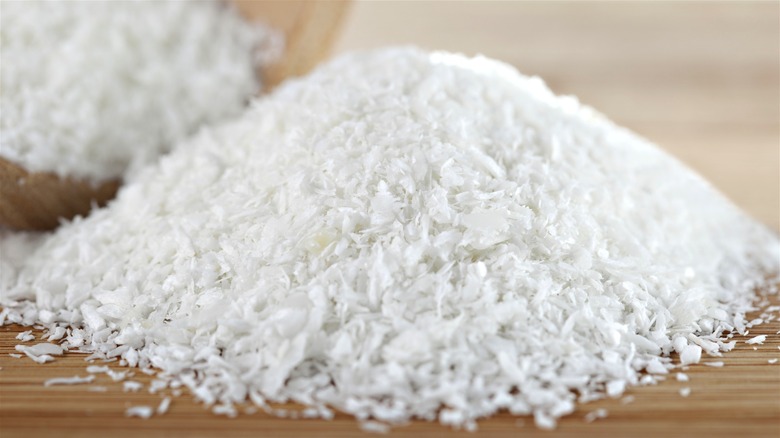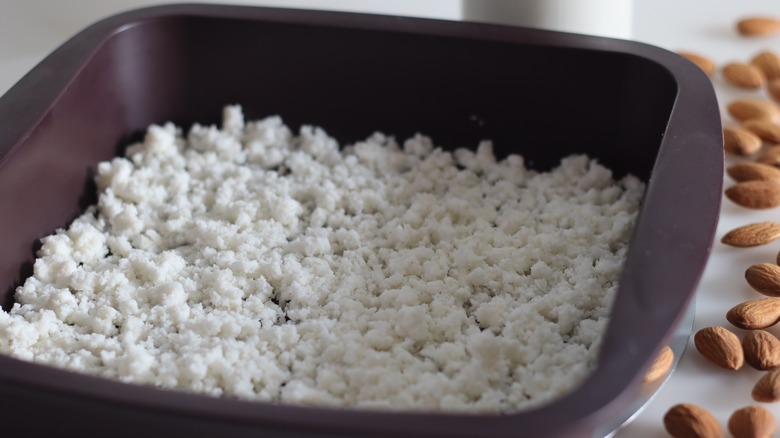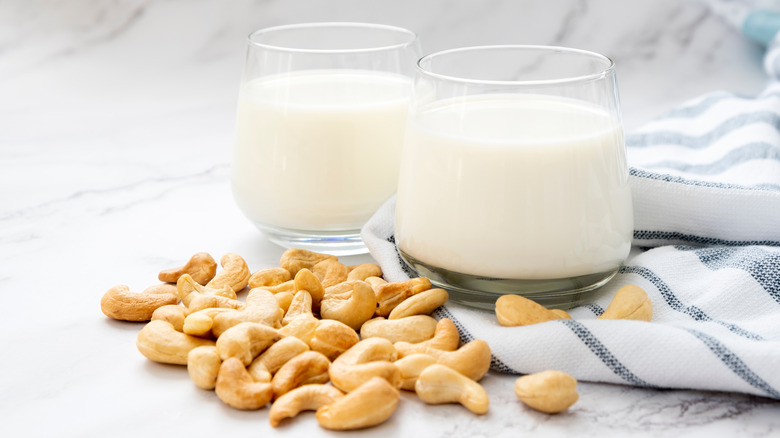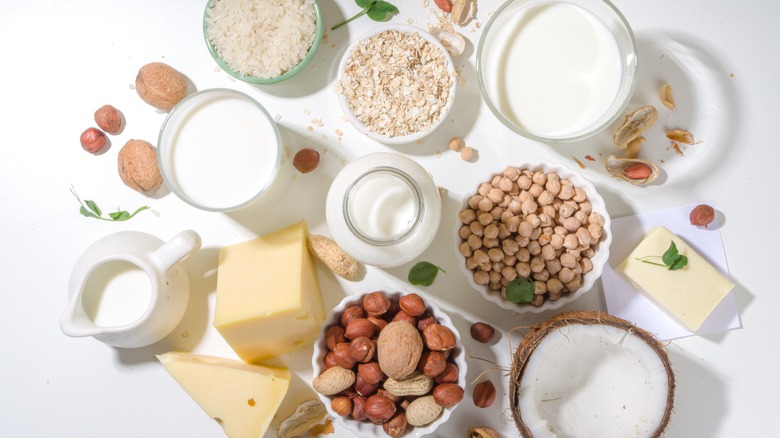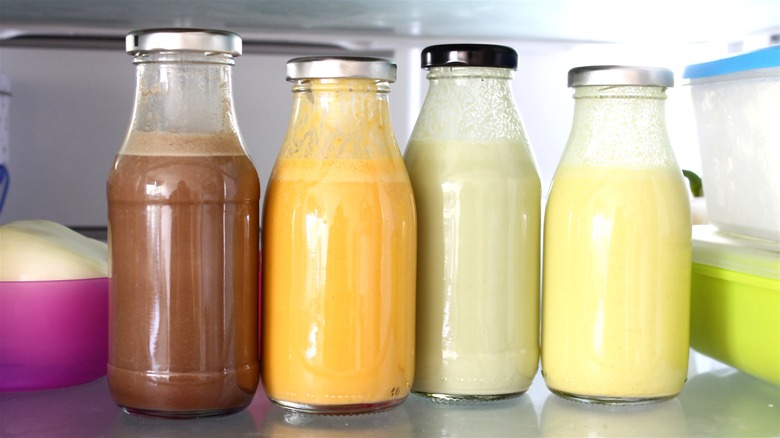The Biggest Mistakes You're Making With Homemade Plant Milk
In the ever-evolving realm of food, where traditional norms are frequently displaced by emerging tastes, a noteworthy drift in milk consumption has been occurring for some time. The younger generation's lack of enthusiasm for cow's milk has been reshaping the dairy industry. In its place, dairy alternatives have risen to the occasion.
But is plant milk capable of filling big dairy's shoes? Extracted from diverse sources, these beverages are supposed to offer a nutritious, sustainable alternative. Remarkably, some even pack a greater nutritional punch than their dairy equivalent, brimming with essential vitamins and minerals while removing the cholesterol. But as climate change (which plant milks are supposed to help combat) drives up their market prices, especially for favorites like oat milk, the tides are shifting yet again. Who knew that considering a milk could be so complicated? Below, some other things to consider if you choose to make your milk at home.
Messing up the ratios
One common misstep among homemade plant milk novices is underestimating the importance of precise ratios. When starting out, it's best to stick with recipes religiously until the basics have been mastered. Achieving the creamy consistency of store-bought versions can be difficult — especially since many are laden with additives — and those making plant milks at home will require generous amounts of nuts and grains.
Experiment with various water-to-base-ingredient proportions — 16:1 for a cost-effective, lighter drink, 8:1 for a store-bought dupe, 4:1 for a thicker, recipe-ready concoction, or even a 2:1 for a luscious cream — until finding the perfect formula. For most homemade plant milks, the recommended ratio is 1 cup of grains or seeds per 4 cups of water.
Going for pre-roasted or salted nuts
At the beginning of anyone's homemade plant milk journey, as they whip up their first glasses of dairy alternative, they might be tempted to grab those roasted or salted nuts off the shelf. But the secret to a natural, clean flavor lies in fresh, unprocessed nuts.
While conventional and dry-roasted ones can make the cut, steer clear of their oil-roasted brethren, lest you surrender nutrition for rancidity. Generally speaking, the less processed, the better. Fancy a flavor boost? Toast or dry roast your own pecans, hazelnuts, and almonds. But remember, seasoned nuts are snack territory. Keep them out of the milking game.
Skipping the soak
When crafting your own plant milk, don't forget to give those base ingredients a bath. This process, known as activation, lets grains, legumes, and hard nuts loosen up and shake off their nutritional inhibitors, becoming easier to digest. The exception is oat, coconut, and small-seed milks.
Soaking times vary: Soybeans demand a twelve-hour soak; almonds, pistachios, and hazelnuts need eight, while oil-rich pecans and walnuts swell up in four to six. Cashews and rice only need two to four hours. But if you have a weak blender, consider increasing soaking times. The result? Softer ingredients that will easily blend into creamier milk — a feature most noticeable in no-strain varieties like cashew.
Using the wrong equipment
In the plant milk equipment hierarchy, the blender is king. So be sure to think twice before putting whole nuts into a regular one. It often lacks the muscle needed for smooth, creamy milk, even if using soaked material. Since the milk will only be as good as the equipment, consider upgrading to one of the high-speed blender brands: Ninja, Nutribullet, or Vitamix are solid contenders. Bullet-style blenders can also handle certain nuts and seeds, thanks to their design.
No high-speed blender? No problem. Even the humblest device can whip up nut butter-based milk that needs no soaking or straining. Just blend a couple tablespoons of nut butter with water and enjoy.
Not paying attention to water temperature and quality
When navigating the world of homemade plant milk, water temperature and quality are waymarks that shouldn't be overlooked. For oat milk, icy water is an ally, keeping the grains from cooking and turning slimy. Coconut milk, on the other hand, insists on a balmy 75 degrees Fahrenheit minimum, as anything colder will result in flavorless, poorly emulsified results.
Don't think any old tap water will do, either. Opt for filtered water, free from chlorine and bacteria, to avoid any unpleasant surprises. For those exercising extra caution, give that water a three-minute boil to bid farewell to any lingering bacteria, then chill it down before blending.
Using nuts past their expiration date
To guarantee the success of that homemade plant milk, be sure to avoid using nuts that are past their prime. Despite their deceptive longevity, nuts do in fact expire. They are oil-rich and, like a summer romance, can turn sour all too fast in balmy weather. The result? A rancid, off-putting milk.
To avoid this, reassess that nut storage. For those who are guilty of pantry stashing, consider relocating to the fridge in a sealed container for six months' worth of freshness. The freezer offers a year-long haven if space is a concern. Remember: Light, oxygen, and heat are worthy adversaries, so choose dark, airtight, and chill for winning results.
Trying to process raw legumes and grains
When it comes to milking legumes and grains, save yourself (and your blender) the trouble, and cook them first. Oats are the exception, ready to dive into the milky fray with no heat required. Rice and quinoa, on the other hand, demand a pre-milking cook-off. Legumes follow suit; peas, for example, require a stovetop simmer until soft and blendable.
However, soybeans can be cooked pre-blend or post-strain, depending on preference for thickness and flavor. Either follow a similar method and cook the beans first for a thicker, richer-tasting milk or — if the equipment allows it — blend the raw soaked beans and simmer the strained liquid instead.
Not using flavorings
Concocting plant milk at home can certainly be more nutritious than drinking store-bought, but the taste often leaves much to be desired. Fortunately, introducing flavor profiles can frequently mask such shortcomings, and they are virtually limitless.
Dates, organic sugar, or maple syrup can naturally sweeten any creation, while a medley of spices like cinnamon, ginger, or nutmeg can deepen the flavor. A dusting of cocoa in hazelnut milk, berries in oat milk, or an infusion of tea instead of blending water can take it up a notch. Remember, moderation is key when it comes to flavoring — start small, adjust to taste, and keep it flavor-free if planning to use it for multiple recipes.
Not blending well enough or overblending
Leaning into an inner need for speed while making plant milk may seem like a thrilling escapade, but it's actually a common blender mistake. Think of blending as a gentle waltz, not a drag race. Patience is key; start slow, then gradually escalate, saving that blender from unnecessary stress and potential splashy chaos.
Beware the perils of over-blending: It will cause the motor to heat up the contents of the pitcher, which can be detrimental to flavor and texture (oat milk, for. example will get slimy). Nevertheless, don't aim for a chunky, under-extracted concoction, either. Remember that the trick to creamy perfection is thoughtful pulsing and short, intense blitzes.
Using the wrong straining tools and techniques
Every drop of milk that flows through the fabric of a muslin nut milk bag, cheesecloth, or fine-mesh strainer is precious. But when it comes to straining, not all milks are cut from the same cloth. For instance, oat milk requires a double strain through a close-knit fabric or an old tee to banish any lingering sediment. On the other hand, cashew, hemp seed, and coconut are more forgiving, dissolving into the liquid when blended at high speed.
Squeezing etiquette also varies. Handle oat milk gently, avoiding a firm squeeze that might coax out unwanted starches, but don't hold yourself back when squeezing nut and soy milks.
Taking sedimentation as a bad sign
In the sea of DIY plant milks, separation is not an ominous sign of spoilage but a natural phenomenon and curious facet of culinary physics. Whether it's the oat milk's dual persona (a creamy underbelly beneath a liquid façade), the coconut milk's theatrical top layer of coconut oil, or the tiger nut horchata's sandy sediment at the base, each has its quirks, but none compromise on taste or nutrition.
The solution to this benign issue of intense, undesired separation? A well-executed shake. So, next time you spy those distinct layers, don't fret — just give it a rhythmic shake, and watch the divided become unified once again.
Not adding fat to oat milks
If a batch of homemade oat milk is more akin to a watercolor wash than a frothy latte, don't despair. The secret to achieving a barista-worthy oat milk at home lies in a surprising ingredient: fat. Take a leaf out of Oatly's book, which owes its creamy consistency to an ample amount of rapeseed oil, and add a touch of coconut or safflower oil to yours.
If the thought of drinking oil has you recoiling, fret not: A trifecta of oats, cashews, and coconut flakes can also work wonders. To ensure a velvet-smooth texture, blend a handful of pre-soaked cashews with water before introducing the oats and coconut. Soon it will yield a luscious, frothy, and decidedly un-slimy plant milk.
Freezing it
Tempting as it may be to freeze that carefully crafted concoction to extend its otherwise tragically short lifespan of 3-5 days, it's best to avoid freezing plant-based milk. Milk, whether it's from a cow or a coconut, is an emulsion — a fusion of fat and water that, much like a quarreling couple, splits up under the stress of freezing. This separation results in discoloration and a grainier texture upon thawing, especially for the fattier types like coconut, almond, and oat milk.
If you're hell-bent on freezing, do it in ice cube trays, then put those cubes straight into coffee, smoothies, or sauces, where texture and color are less critical.
Forgetting to fortify
If you're not amping up homemade plant milk with a nutritional boost from whole food additives, or a dash of store-bought protein powder, you're missing out.
Those dodging animal products should fortify with vital supplements such as calcium, D3, and B12, available in both powder and liquid form. You'll find tailor-made superfood blends to fortify your milk online, but often a pantry holds the key. For example, by adding hemp or flaxseeds, you're infusing the concoction with a potent dose of omega-3, omega-6, and a good chunk of fiber, while sesame seeds pack a serious calcium punch. After adding fortifiers, give everything a good blitz in the blender for a smooth mix.
Sticking to just one kind of base
Plant milk can be made from dozens of nuts, grains, seeds, legumes, and even tubers, so why stop at almond and oat?
For example, pecan milk is a nutritional powerhouse, offering a bountiful source of vitamins A, B, and E and omega-3 fats. Peanut milk, a legume derivative, is another protein-packed, eco-friendly contender. Sesame seed, which has sprouted another alternative milk trend, is superior to almond and cashew in terms of sustainability. Also, why not consider economical options like sunflower and pumpkin seed milk? There is no shortage of nutritious, flavorful, cost-effective, and sustainable types of plant milk to explore; folks are even making milk from potatoes.
Failing to extend its shelf-life
Seeking longevity for your homemade plant milk? There's a foolproof method. First, cleanliness is king: Sterilize everything from blender to bottles, and always wash your hands. Next, use a dishwasher-safe, double-layered, ultra-fine nylon mesh strainer instead of a milk bag to yield the silkiest milk sans human touch. For almond and hazelnut milk, blanch the nuts and soak them in the fridge.
Post-production, swiftly decant that masterpiece under an airtight lid into the refrigerator, as being exposed to air and bacteria is the catalyst for spoilage. Finally, refrigerate enough for a couple of days, then freeze the surplus in ice cube trays. Voila! Longer-lasting, fresher plant milk at your fingertips.
Not using emulcifiers
Unless you're steering away from commercial plant milk specifically because of its additives, consider experimenting with emulsifiers when crafting homemade alternatives. Take xanthan gum, a plant-based additive that can transform almond milk into a luxuriously whipped cream(although increasing the milk's fat content with oil or cashews will work too). Or perhaps sunflower lecithin, a nifty emulsifier that coaxes the water and plant fats into a harmonious mixture, crafting a uniform beverage that won't separate.
Tread carefully: While these additions can enhance visual appeal and frothiness, they could also prompt some gut discomfort. So, if you're not avoiding dairy for health reasons, these could be a secret weapon for more satisfying homemade milk.
Letting oat milk get slimy
Mastering the art of homemade oat milk means knowing how to dodge committing slime crimes. First, soaking and rinsing oats can result in a mucilaginous mess, thanks to the stubborn starch called beta-glucan.
Next, be sure to treat your blender like a cold-pressed juicer, not a porridge pot: avoid warm water and over-blending. When it comes to straining, a gentle squeeze through a towel trumps a cheesecloth unless you're a fan of starchy squirts. Finally, add a few store-bought digestive enzyme capsules and marvel as they tame the sliminess. However, they might also thin out your milk to a skim-like consistency, but it's a trade-off that could suit some palates.
Not using cheat ingredients in a pinch
Whether you're in a rush, out of some key ingredients, or unsure of your blender's horsepower, you can always conjure up plant-based milk from some pantry staples.
Even with a modest blender, you can churn out milk from raw, unsalted, and unroasted nut butter using a simple ratio of two tablespoons per one-and-a-half cups of water. If the dangers of breaking open a coconut are what's been stopping you from making coconut milk, try shredded, unsweetened coconut flakes instead; no soaking required. Or, if you're looking for easy slime-free oat milk, reach for oat flour or a blend of oat and nut flours, ready in a blink.
Letting the pulp go to waste
A plant milk novice might be tempted to throw leftover pulp in the garbage or, best case scenario, compost it. If that's you, here's a PSA: You need to stop throwing it out.
Freeze it instead into popsicles or blend into smoothies. Transform leftover almond pulp into a thrifty alternative to pricey flour — it's not quite a like-for-like, but could work for some vegan crinkle cookies. More nut pulp? Craft it into a scrumptious spread or a raw vegan crust. The oat pulp, a chameleon of sorts, melds into breakfast recipes effortlessly. Finally, okara (the soybean pulp) invites a whole new dimension to savory dishes.
Picking the wrong milk for the job
Once you've made your milk, use it wisely. Dollop date-sweetened oat milk into a curry? Not on our watch. Nor should you toss curdle-prone cashew milk into coffee or enlist slightly bitter walnut milk in your morning cereal. Knowledge is power, so study what different plant-based milks are best for.
Unsweetened soy milk shines as a mashed potato companion and a buttermilk base. Almond milk excels in baking and coffee, and so does naturally sweet and frothy oat milk. Coconut milk adds richness and body to soups and curries. As for cashew milk? A jack-of-all-trades, suitable for smoothies, oatmeal, breakfast dishes, and savory foods, thanks to its modest sweetness and creamy texture.
Letting it curdle in hot drinks
Ever marveled at the unappetizing curdled layer in your hot brew? Fear not, it's not a sign of spoiled plant milk, but rather a harmless reaction to heat and acidity, easily remedied with a quick stir.
To prevent plant milk from curdling, consider using different beans or diluting the coffee with water to decrease acidity. Temperature plays a key role, too; allow the coffee to cool slightly or gently warm the milk, but remember, plant milks are delicate. High heat is their nemesis, so never venture above 140 degrees Fahrenheit. Finally, while soy, coconut, almond, and rice milk tend to curdle more readily, oat milk might be your best bet.
Heating it up too much
Heating plant-based milks is a surprisingly delicate process, compared to the brutal blending it first has to undergo. Soy and coconut milk can tolerate high heat without curdling, making them the stars of sauces, soups, and bakes.
Almond, on the other hand, is less reliable. Apply too much heat, and the result is a bitter, separating mess. Oat milk's a dream team player for hot drinks and foods, if treated right. You can gently coax it to warmth on the stovetop or in the microwave. For an even gentler approach, try the double boiler method. If it starts to thicken, dial down the heat and stir like you mean it.
Stopping at milk
Imagine this: Your homemade plant milk, transformed into a full-fledged vegan creamery. Intriguing, right? Tinker with the ratios, and you've got a thicker, creamier foundation for a myriad of recipes.
Try vegan buttermilk, made from curdle-prone milks like soy or cashew — just add a splash of vinegar or lemon juice, and voilà. Mixed with coconut oil, this concoction can even be turned into vegan butter. Additionally, using a vegan starter culture or a probiotic capsule, you can cultivate plant-based yogurts, and employ tapioca starch to turn it into cheese. Don't forget about the decadent possibilities of condensing fatty coconut milk or beating it with powdered sugar for some whipped cream.
Missing the moment when it goes bad
To paraphrase Kenny Rogers: you've got to know when to fold 'em. This is especially true when it comes to homemade nut milk.
Unlike their store-bought, pasteurized kin, these culinary concoctions have a much shorter fridge life, so vigilance is key. Most homemade varieties will keep for a mere 3-5 days. Now, onto the tricky part: spotting a milk gone rogue. If it's sour, chunky, discolored, or smells off, toss it. Milk that isn't moldy or smelly is a safe bet, while clumpy almond milk, foul-smelling rice milk, or oat milk that's more akin to yogurt than milk should be chucked. Remember, when in doubt, pour it out.
